The AMD Ryzen 9 7950X3D Review: AMD's Fastest Gaming Processor
by Gavin Bonshor on February 27, 2023 9:00 AM ESTCPU Benchmark Performance: Power And Office
Our previous sets of ‘office’ benchmarks have often been a mix of science and synthetics, so this time we wanted to keep our office section purely on real-world performance. We've also incorporated our power testing into this section too.
The biggest update to our Office-focused tests for 2023 and beyond include UL's Procyon software, which is the successor to PCMark. Procyon benchmarks office performance using Microsoft Office applications, as well as Adobe's Photoshop/Lightroom photo editing software, and Adobe Premier Pro's video editing capabilities. Due to issues with UL Procyon and the video editing test, we haven't been able to properly run these, but once we identify a fix with UL, we will re-test each chip.
We are using DDR5 memory on the Ryzen 9 7950X3D and the other Ryzen 7000 series we've tested. This also includes Intel's 13th and 12th Gen processors. We tested the aforementioned platforms with the following settings:
- DDR5-5600B CL46 - Intel 13th Gen
- DDR5-5200 CL44 - Ryzen 7000
- DDR5-4800 (B) CL40 - Intel 12th Gen
All other CPUs such as Ryzen 5000 and 3000 were tested at the relevant JEDEC settings as per the processor's individual memory support with DDR4.
Power
The nature of reporting processor power consumption has become, in part, a bit of a nightmare. Historically the peak power consumption of a processor, as purchased, is given by its Thermal Design Power (TDP, or PL1). For many markets, such as embedded processors, that value of TDP still signifies the peak power consumption. For the processors we test at AnandTech, either desktop, notebook, or enterprise, this is not always the case.
Modern high-performance processors implement a feature called Turbo. This allows, usually for a limited time, a processor to go beyond its rated frequency. Exactly how far the processor goes depends on a few factors, such as the Turbo Power Limit (PL2), whether the peak frequency is hard coded, the thermals, and the power delivery. Turbo can sometimes be very aggressive, allowing power values 2.5x above the rated TDP.
AMD and Intel have different definitions for TDP that are, broadly speaking, applied the same. The difference comes from turbo modes, turbo limits, turbo budgets, and how the processors manage that power balance. These topics are 10000-12000 word articles in their own right, and we’ve got a few articles worth reading on the topic.
- Why Intel Processors Draw More Power Than Expected: TDP and Turbo Explained
- Talking TDP, Turbo and Overclocking: An Interview with Intel Fellow Guy Therien
- Reaching for Turbo: Aligning Perception with AMD’s Frequency Metrics
- Intel’s TDP Shenanigans Hurts Everyone
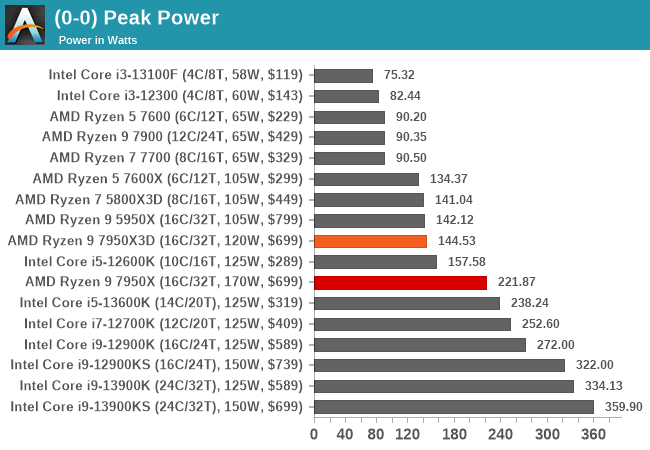
Given that the Ryzen 9 7950X3D has a lower TDP and PPT rating than the Ryzen 9 7950X, it pulls less power. We observed a peak power output of 144.53 W on the 7950X3D, compared to 221.87 W on the 7950X. Talking figures, the Ryzen 7950X3D is pulling around 65% of the power of the 7950X, which is understandable given the power limitations due to the CCX laden with AMD's 3D V-Cache packaging.
Looking at the power consumption of the Ryzen 9 7950X3D in closer detail, we can see that it delivered a consistent load of between 140 and 144 W in our Prime95 sustained power test. This is around 18 Watts lower than the official Package Power Tracking (PPT) level AMD has set at 162 W. However, it operates higher than the TDP of 120 W, which is to be expected. The TDP and PPT ratings are different as the TDP is the base power the CPU should be drawing, while the PPT (socket), set at 162 W, is the maximum the processor can draw as a maximum under full load.
Office/Web
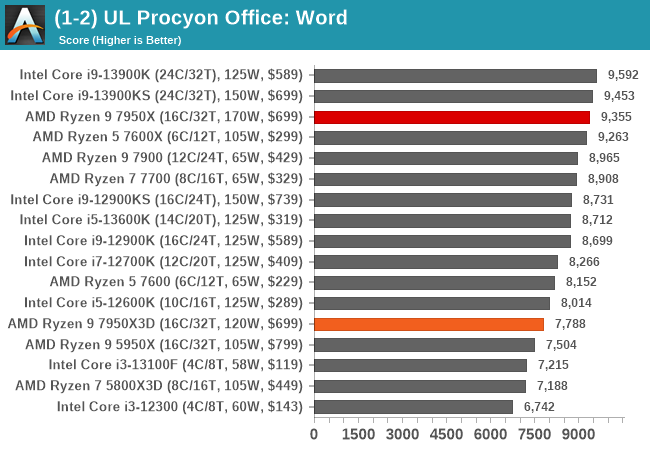
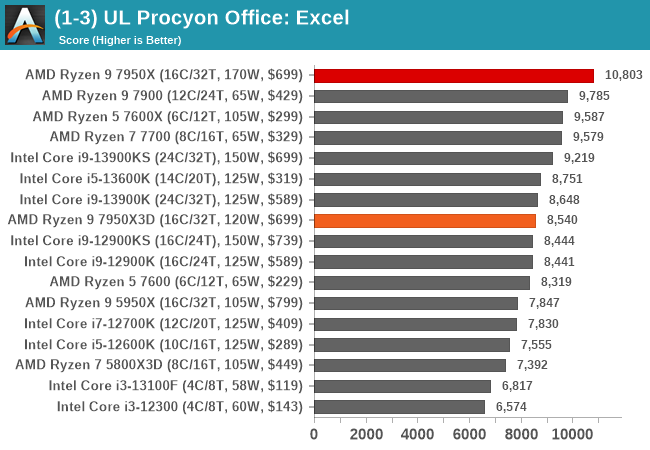
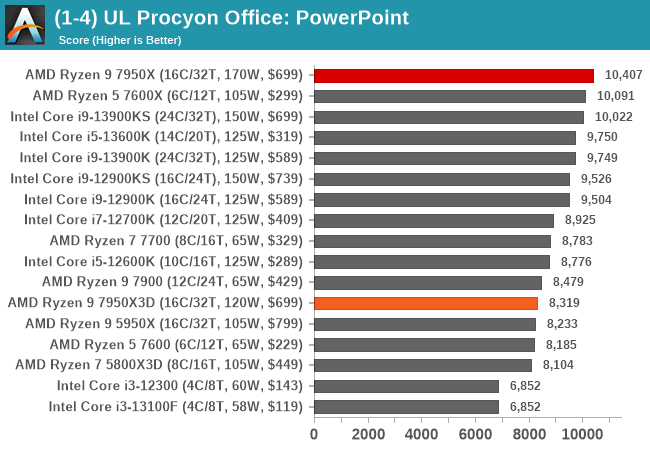
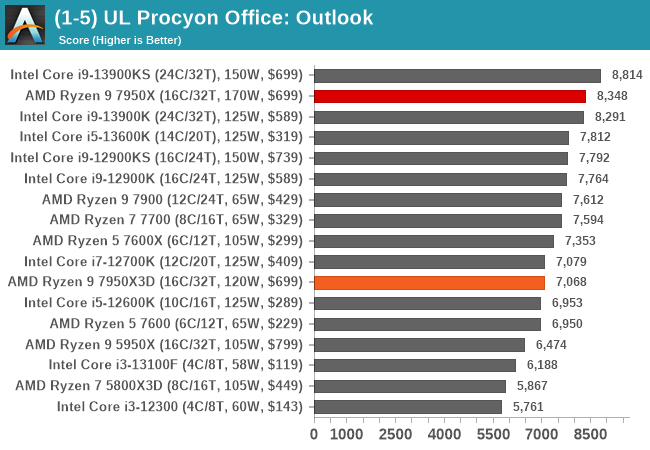
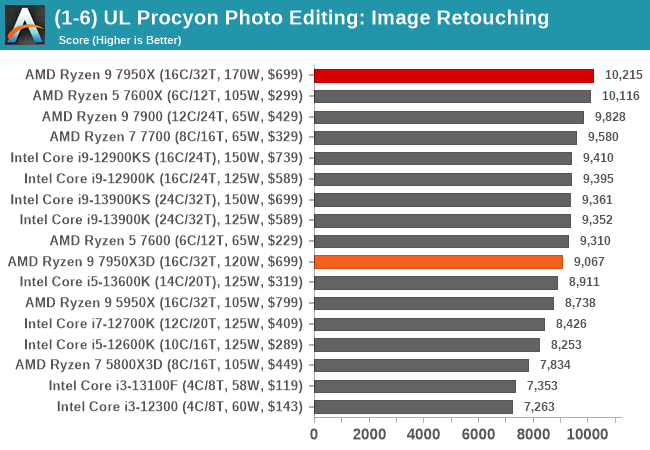
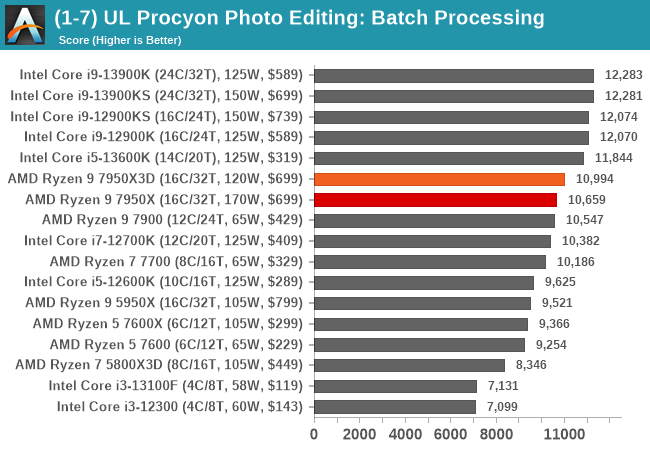
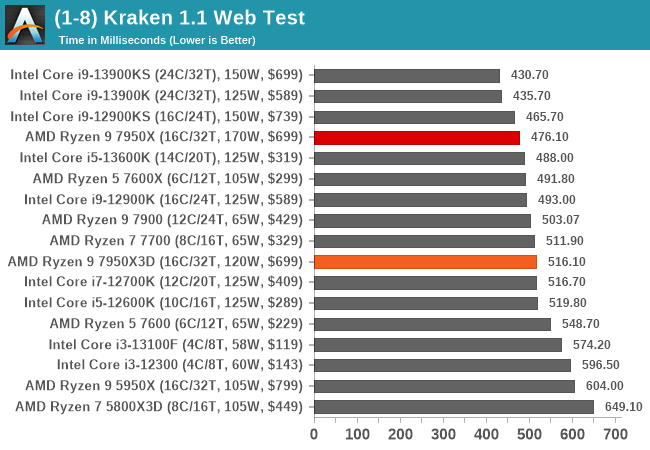
In our office-based testing, the Ryzen 9 7950X3D performs a little worse than the 7950X, but this is to be expected given the differences in TDP, PPT, and the overall power envelope. Still, the 7950X3D performs well and is more than suitable for office and web-based tasks.


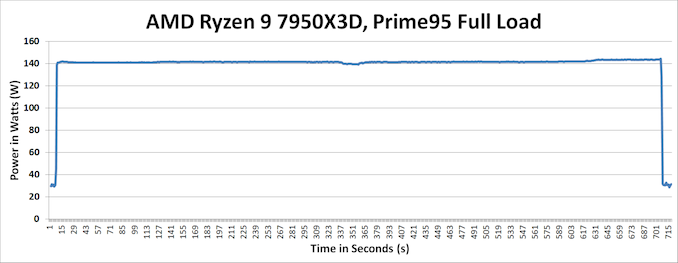








122 Comments
View All Comments
mikato - Tuesday, February 28, 2023 - link
I noticed that Ryzen 3000 is mentioned several times, but not included in any of the charts. It would've been nice to see one of those in there.kayak - Tuesday, February 28, 2023 - link
I'll wait benchmark with the cache preference in the bios. I'm not fan of these additional layers like microsoft game bar, some people disable it and it looks like it doesnt help for factorio anyway. If bios settings set to cache preference can fix most of problems i'm fine, not everyone use windows.iRacer - Tuesday, February 28, 2023 - link
Your V-Ray bnenchmark scores are all over the place.A current 7950X scores on average 29k vsamples.
How are you getting these values, and how can the reader know the method is proper, given you're sitting on double the real values?
iRacer - Tuesday, February 28, 2023 - link
Gavin, once again: your V-Ray benchmark score do *not* reflect what can be seen here (https://benchmark.chaos.com/v5/vray?search=7950x&a... by TWICE the amounts.How are you reaching these values?
Do i have to ask you officially via email, or can you reply directly?
I am *clearly* an intersted party under anonymity.
If you read and delete the comment, you are well able to reply instead.
iRacer - Tuesday, February 28, 2023 - link
nevermind, nothing was deleted, but the "link" above the post doesn't work and leads to a 404.iRacer - Tuesday, February 28, 2023 - link
*if used right after posting.Gavin Bonshor - Thursday, March 2, 2023 - link
Hi iRacer. I'm certainly not ignoring you.I'm pretty sure I replied to a similar comment in another review.
You are more than welcome to reach out to me via email for a discussion, but we are using V-Ray version 4.10.06
As per our 5950X review/testing as per Dr. Ian Cuttress here: https://www.anandtech.com/show/16214/amd-zen-3-ryz...
This correlates with the result/data I have in my testing in this review. You also can't compare results between different versions of the benchmark.
I'll run the latest version when I get a moment tomorrow and let you know. In the mean-time, feel free to email me if you wish to continue the discussion there. It's easier to keep track of via email than it is to trawl through comments.
Thanks!
P.S.: The only time I'll delete a comment I've seen is if it's spam.
mikato - Tuesday, February 28, 2023 - link
"the Ryzne 9 7950X3D doesn't quite hit"Also, this single-sentence paragraph (below) appears on both page 4 and 5. Maybe it doesn't belong on page 4.
"In the encrypt/decrypt scenario, how data is transferred and by what mechanism is pertinent to on-the-fly encryption of sensitive data - a process by which more modern devices are leaning to for software security."
Thank you for your great coverage.
Ket_MANIAC - Wednesday, March 1, 2023 - link
AMD's core efficiency is out of this world. The 16 core 7950X3D performs at the same power level as the 6 core 7600X. This is unheard of and unimaginable!Silver5urfer - Wednesday, March 1, 2023 - link
Late to commment, but I already mentioned.3D V has it's limitations. AMD cannot improve this on Gen 2 with any Clock boost or such. It has same downsides, the Base clock reduction and Max Clock reduction. And the Unlocked Multiplier lock.
This processor is only for those "Gamers" And it does not make sense on the 7950X3D at all. A loss of TDP power window, loss in every thing that scales with Cores + Clocks.
Also Ryzen 7000 / Zen 4 is ultra optimized by default, it has super low voltage. 1.2v max at such high insane 5.x GHz clock rate vs Zen 3. TSMC 5N is a massive gain and also Zen 4 optimization. Now the X3D runs at high voltage. This is opposite of Zen 3 X3D, as 5800X3D ran at 1.3v binned and stock was 1.4v. Now roles are flipped. Meaning Zen 4 is at it's maximum potential.
Ultimately the choice for any PC DIYer is to get Zen 4 over RPL because Intel LGA1700 socket is an engineering failure. You should not resort to modding with Contact Frame on a $700 Mobo. Period. Zen 4 has a limit on PCH Chipset speed, the X670 apart from that, no downsides. I'd pick 7950X over any Zen 4 processor for a Zen 5 upgrade. RPL Refresh is not going to change socket ofc and not gonna do massive changes either, at best DLVR, optimization on TDP and optimization to Base and Boost Clockspeed. Intel 7 is also at it's max, plus it's an EOL design. Look at ADL vs RPL literally they gave E cores garbage and added Cache to have "Marginal" boost in games. and E cores to accelerate MT workloads. Pathetic. And now RPL refresh literally another BS Single digit gain. Look at Zen 3 vs Zen 4. Ultimate lead.
That said, I'm only looking for 7800X3D because it has higher TDP and almost same Clock Rate. Still capped Multiplier, anyways AMD processors are not good for tinkerers that much since you cannot control Clock rate and cannot have fixed Clocks either. At best Curve Optimization and DRAM tuning. So if you are into that stick with Intel.